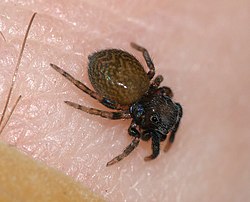| Neon valentulus | |
|---|---|
 | |
| Scientific classification | |
| Kingdom: | Animalia |
| Phylum: | Arthropoda |
| Subphylum: | Chelicerata |
| Class: | Arachnida |
| Order: | Araneae |
| Infraorder: | Araneomorphae |
| Family: | Salticidae |
| Genus: | Neon |
| Species: | N. valentulus |
| Binomial name | |
| Neon valentulus Falconer, 1912 | |
 | |
Neon valentulus is a species of jumping spider found from Europe to Central Asia. [1] It is only found in marshy areas. [2]
Contents
Neon valentulus rarely jumps, and has been found living deep within rotten logs.
